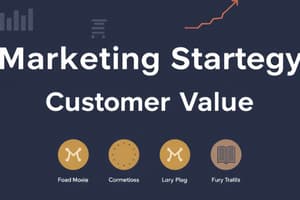Podcast
Questions and Answers
Which of the following best describes marketing myopia?
Which of the following best describes marketing myopia?
- Broadly defining a business in terms of solutions customers seek.
- Focusing only on existing wants and losing sight of underlying consumer needs. (correct)
- Balancing company profits, customer wants, and society's interests.
- Focusing primarily on societal impact of marketing decisions.
The 'selling concept' believes that consumers will automatically purchase enough of a company's products without substantial promotional effort.
The 'selling concept' believes that consumers will automatically purchase enough of a company's products without substantial promotional effort.
False (B)
What is the main goal of demarketing?
What is the main goal of demarketing?
Reduce demand
The set of benefits or values a company promises to deliver to customers to satisfy their needs is known as the company's ______.
The set of benefits or values a company promises to deliver to customers to satisfy their needs is known as the company's ______.
Match the following marketing management orientations with their corresponding descriptions:
Match the following marketing management orientations with their corresponding descriptions:
Which of the following is the most accurate definition of 'marketing'?
Which of the following is the most accurate definition of 'marketing'?
Customer 'wants' are the same as customer 'needs'.
Customer 'wants' are the same as customer 'needs'.
What are the 4Ps of the marketing mix?
What are the 4Ps of the marketing mix?
The act of obtaining a desired object from someone by offering something in return is known as ______.
The act of obtaining a desired object from someone by offering something in return is known as ______.
What is the primary focus of the 'societal marketing concept'?
What is the primary focus of the 'societal marketing concept'?
Market segmentation involves selecting which segments to target with marketing efforts.
Market segmentation involves selecting which segments to target with marketing efforts.
What is 'customer lifetime value'?
What is 'customer lifetime value'?
'______' is the portion of the customer's purchasing that a company gets in its product categories.
'______' is the portion of the customer's purchasing that a company gets in its product categories.
Customer Relationship Management (CRM) primarily focuses on:
Customer Relationship Management (CRM) primarily focuses on:
Partner relationship management only involves managing relationships with entities outside of the company.
Partner relationship management only involves managing relationships with entities outside of the company.
What is the purpose of an integrated marketing program?
What is the purpose of an integrated marketing program?
A channel that stretches from raw materials to components to final products to final buyers is known as a ______.
A channel that stretches from raw materials to components to final products to final buyers is known as a ______.
What is the core principle behind the marketing concept?
What is the core principle behind the marketing concept?
Demands are 'wants' backed by buying power.
Demands are 'wants' backed by buying power.
Match the term to the definition:
Match the term to the definition:
Flashcards
What is Marketing?
What is Marketing?
The process by which companies create value for customers and build strong customer relationships in order to capture value from customers in return.
What are Needs?
What are Needs?
States of felt deprivation, including physical, social, and individual needs.
What are Wants?
What are Wants?
The form human needs take as they are shaped by culture and individual personality.
What are Demands?
What are Demands?
Signup and view all the flashcards
What are Market offerings?
What are Market offerings?
Signup and view all the flashcards
What is Exchange?
What is Exchange?
Signup and view all the flashcards
What are Markets?
What are Markets?
Signup and view all the flashcards
What is Marketing management?
What is Marketing management?
Signup and view all the flashcards
What is Market Segmentation?
What is Market Segmentation?
Signup and view all the flashcards
What is Target marketing?
What is Target marketing?
Signup and view all the flashcards
What is Demarketing?
What is Demarketing?
Signup and view all the flashcards
What is a Value proposition?
What is a Value proposition?
Signup and view all the flashcards
What is the Production concept?
What is the Production concept?
Signup and view all the flashcards
What is the Product concept?
What is the Product concept?
Signup and view all the flashcards
What is the Selling concept?
What is the Selling concept?
Signup and view all the flashcards
What is the Societal marketing concept?
What is the Societal marketing concept?
Signup and view all the flashcards
What is the Marketing mix?
What is the Marketing mix?
Signup and view all the flashcards
What is Customer Relationship Management (CRM)?
What is Customer Relationship Management (CRM)?
Signup and view all the flashcards
What is Customer lifetime value?
What is Customer lifetime value?
Signup and view all the flashcards
What is Share of customer?
What is Share of customer?
Signup and view all the flashcards
Study Notes
Creating and Capturing Customer Value: Topic Outline
- Key areas include defining marketing, understanding the marketplace and customer needs, designing a customer-driven strategy, and preparing an integrated marketing plan
- Additional components involve building customer relationships, capturing value from customers, and understanding the changing marketing landscape
What is Marketing?
- Marketing is a process where companies create customer value and build strong relationships in order to capture value in return
The Marketing Process
- Begins with understanding the marketplace and customer needs/wants; then, designing a customer-driven marketing strategy
- Constructing an integrated marketing program that delivers superior value is part of the process
- This leads to building profitable relationships and creating customer delight
- Ultimately, the goal is to capture value from customers to create profits and customer equity
Understanding the Marketplace and Customer Needs: Core Concepts
- It is important to consider customer needs, wants, and demands
- Market offerings, value and satisfaction, exchanges and relationships, and markets are core concepts to note
Customer Needs, Wants and Demands
- Needs are states of deprivation including physical (food, clothing, safety), social (belonging, affection), and individual (knowledge, self-expression) needs
- Wants are the form needs take as they are shaped by culture and individual personality
- Demands are wants backed by buying power
Understanding the Marketplace and Customer Needs
- Market offerings are combinations of products, services, information or experiences that are offered to a market to satisfy a need or want
- Marketing myopia is focusing only on existing wants, and losing sight of underlying consumer needs
Customer Value and Satisfaction Expectations
- Marketers must set the right level of expectations for customers
- It is important to ensure expectations are not too high or too low with value and satisfaction
Understanding the Marketplace and Customer Needs
- Exchange is the act of obtaining a desired object from someone by offering something in return
- Markets are the set of actual and potential buyers of a product
Designing a Customer-Driven Marketing Strategy
- Marketing management involves choosing target markets and building profitable relationships
- It requires answering the questions: "What customers will we serve?" and "How can we best serve these customers?"
Selecting Customers to Serve
- Market segmentation divides markets into segments of customers
- Target marketing is the process of selecting segments to pursue
Selecting Customers to Serve
- Demarketing is marketing to reduce demand temporarily or permanently
- The aim of demarketing is to reduce or shift demand, rather than destroy it
Choosing a Value Proposition
- Value proposition is the set of benefits or values a company promises to deliver to customers to satisfy their needs
Marketing Management Orientations
- Key concepts include production, product, selling, marketing, and societal concepts
Marketing Management Orientations
- Production concept is the idea that consumers will favor products that are available or highly affordable
Marketing Management Orientations
- Product concept is the idea that consumers will favor products that offer the most in quality, performance, and features
- Organizations should devote its energy to making continuous product improvements
Marketing Management Orientations
- Selling concept is the idea that consumers will not buy enough of a firm's products unless it undertakes a large-scale selling and promotion effort
Marketing Management Orientations
- Marketing concept is the idea that achieving organizational goals depends on knowing the needs and wants of target markets and delivering the desired satisfactions better than competitors do
Marketing Management Orientations
- Societal marketing concept is the idea that a company should make good marketing decisions by considering consumers' wants, company requirements, consumers' long-term interests, and society's long-run interests
Designing a Customer-Driven Marketing Strategy
- Marketing strategy takes into consideration society (human welfare), consumers (want satisfaction), and company (profits)
Preparing an Integrated Marketing Plan and Program
- The marketing mix is the set of tools (four Ps) firms use to implement its marketing strategy
- This includes product, price, promotion, and place
- An integrated marketing program is a comprehensive plan that communicates and delivers intended value to chosen customers
Building Customer Relationships
- Customer Relationship Management (CRM) is the overall process of building and maintaining profitable customer relationships
- It involves delivering superior customer value and satisfaction
Relationship Building Blocks: Customer Value and Satisfaction
- Customer-perceived value is the difference between total customer value and total customer cost
- Customer satisfaction is the extent to which a product's perceived performance matches a buyer's expectations
Customer Relationship Levels and Tools
- Strategies includes basic relationships and full partnerships
The Changing Nature of Customer Relationships
- Selected customers are carefully selected to manage relationships which targets fewer and more profitable customers
- Relationships are two-way and interactive through blogs, websites, online communities, and social networks
Building Customer Relationships
- Partner relationship management involves working closely with partners in other departments and outside the company to jointly bring greater value to customers
Partner Relationship Management
- Partners inside the company include every function area interacting with customers electronically and with cross-functional teams
- Partners outside the company is how marketers connect with suppliers, channel partners, and competitors to develop partnerships
Partner Relationship Management
- Supply chain is a channel that stretches from raw materials to components to final products to final buyers
- It is important to consider supply management, strategic partners and strategic alliances
Capturing Value From Customers
- Customer lifetime value is the value of the entire stream of purchases that the customer would make over a lifetime of patronage
Capturing Value from Customers
- Share of customer is the portion of the customer's purchasing that a company gets in its product categories
Capturing Value From Customers
- Customer equity is the total combined customer lifetime values of a company's customers
Building Customer Equity
- Building the right relationships with the right customer involves treating customers as assets that need to be managed and maximized
- Different types of customers require different relationship management strategies and building the right relationship with the right one
The Changing Marketing Landscape: Major Developments
- Digital age, rapid globalization, ethics and social responsibility, and not-for-profit marketing
Studying That Suits You
Use AI to generate personalized quizzes and flashcards to suit your learning preferences.




